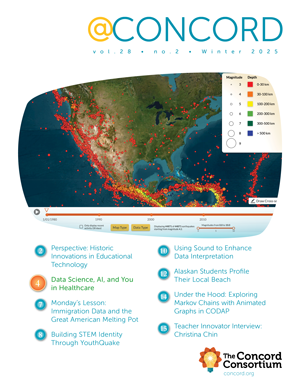Molecular Workbench and the New Standards, Seeing Heat Transfer, Mixed Reality Brings Science Concepts to Life, and more in Spring @Concord
Perspective: Improving STEM Education with Next Generation Science Standards
These are exciting times in education. Public awareness of the need for science, technology, engineering and math education is rising, and new STEM initiatives are beginning across the nation. In this issue, we welcome one of the most important events in this new awareness of STEM, the release of the Next Generation Science Standards (NGSS). These new standards highlight important new dimensions for science education and present many opportunities for technology to aid teaching and learning.
Molecular Workbench and the New Standards
The Next Generation Science Standards (NGSS) raise many challenges for science teaching and learning. The standards ask teachers to cover fewer science ideas in more depth than currently while placing far greater emphasis on crosscutting concepts and science practices. Making these changes requires new content, pedagogical techniques and tools. Powerful computer-based tools like Molecular Workbench can address these challenges by allowing students to learn from their own investigations how a simple set of core concepts can explain a wide range of observations that cut across fields and disciplines. This can build student understanding of science practices, crosscutting themes and core ideas all at the same time.
Monday’s Lesson: Seeing Heat Transfer
Imagine if you could see the temperature of every surface in your house as a moving, colorful collage—red for hot pockets and currents of air, blue for cold, plus yellow and orange for rising and falling temperatures. This would allow you to follow the transfer of heat through the materials and the motion of warm and cold air throughout the building.
Meet NGSS with Concord Consortium Activities
Technology provides many ways for teachers and students to engage with the NGSS more deeply.
The Future of Fracking: Exploring Human Energy Use
Today few states require Earth science as part of the high school curriculum—despite the fact that both NSES and AAAS Benchmarks have substantial Earth and space science content standards. However, this may change. The Next Generation Science Standards (NGSS) give equal importance to Earth and space science, physical science, life science and engineering. And it’s likely that the 26 Lead State Partners that helped develop the standards will adopt them in their entirety, which could provide a significant motivation for incorporating more Earth and space science content into their required curriculum.
Mixed Reality Brings Science Concepts to Life
In his Critique of Pure Reason, the Enlightenment philosopher Immanuel Kant asserted that “conception without perception is empty; perception without conception is blind... The understanding can intuit nothing, the senses can think nothing. Only through their union can knowledge arise.” More than 200 years later, his wisdom is still enlightening our work in mixed-reality science experiments.
Under the Hood: Inputs and Outputs to Next-Generation MW Interactives
Our Next-Generation Molecular Workbench (MW) allows you to build Web-based simulations to explore emergent scientific phenomena. Years of experience tell us that learning happens best when students actively manipulate such models to ask and answer questions—and the Next Generation Science Standards call for students to do just that. Next-Generation MW helps foster inquiry with models by supporting custom properties, which you can define to expose the most relevant features of the model to observation and direct manipulation.
Innovator Interview: Sam Fentress
Meet Concord Consortium software developer Sam Fentress. Learn about his connections to Italy, why he believes in open source code, and more.
Find your path through the NGSS
Find your path through the Next Generation Science Standards with help from the Concord Consortium.




